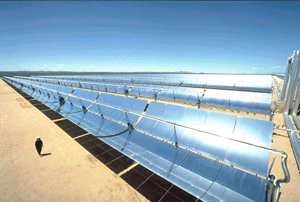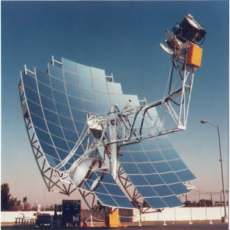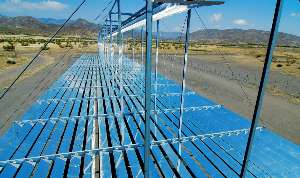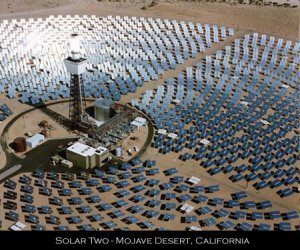|
Solar Electric Power can be gained using several different technologies
|
 A Parabolic Trough system uses lines of parabolic troughs to reflect sunlight to a focal line across them. These reflectors use an automated tracking system to follow the sun during the day, just as heliostats do in solar power towers structures. A tube which is located along the focal line of the troughs, absorbs the solar thermal energy to heat the fluid running through it. Usually, this fluid is oil, that is then used to drive an electrical generator. Latest designs add a thermal storage tank, in order to continue working at night. Huge structures using parabolic trough collectors reach high energy capacities. It is worth mentioning that the largest plant today is located in California and it produces 125 MW.
A Parabolic Trough system uses lines of parabolic troughs to reflect sunlight to a focal line across them. These reflectors use an automated tracking system to follow the sun during the day, just as heliostats do in solar power towers structures. A tube which is located along the focal line of the troughs, absorbs the solar thermal energy to heat the fluid running through it. Usually, this fluid is oil, that is then used to drive an electrical generator. Latest designs add a thermal storage tank, in order to continue working at night. Huge structures using parabolic trough collectors reach high energy capacities. It is worth mentioning that the largest plant today is located in California and it produces 125 MW.
 Solar Dishes look like a satellite dish antenna. The difference is that instead of focusing radio-magnetic waves, they concentrate the rays of the sun to a specific point. To do that, they use automated tracking systems to follow the sun throughout the day. On their focal point, a Stirling engine usually takes advantage of the solar thermal energy to produce electricity. Different designs may heat water to use the steam for energy production, just as parabolic troughs and solar power towers do. Recently, students of the MIT have designed a cost effective solar dish which is expected to significantly help driving an environmentally sustainable future.
Solar Dishes look like a satellite dish antenna. The difference is that instead of focusing radio-magnetic waves, they concentrate the rays of the sun to a specific point. To do that, they use automated tracking systems to follow the sun throughout the day. On their focal point, a Stirling engine usually takes advantage of the solar thermal energy to produce electricity. Different designs may heat water to use the steam for energy production, just as parabolic troughs and solar power towers do. Recently, students of the MIT have designed a cost effective solar dish which is expected to significantly help driving an environmentally sustainable future.
 Fresnel Reflectors/Lens work in exactly the same way as parabolic troughs do. Why are they named differently? Because they are in a larger scale. These mirrors are placed in huge lines but they do not concentrate the light on a line above each other. Instead, they drive it to hit a central tube-absorber running above all of them.
Fresnel Reflectors/Lens work in exactly the same way as parabolic troughs do. Why are they named differently? Because they are in a larger scale. These mirrors are placed in huge lines but they do not concentrate the light on a line above each other. Instead, they drive it to hit a central tube-absorber running above all of them.
If you have some time, it is worth to have a look at the Solar Electric Power Association.
P.S. Solar Electric Power generation is becoming more and more efficient. The technologies described above are relatively new and they are currently used for massive energy production (in Solar PV Farms for example). Soon they will arrive at our homes too. Just be patient!
| Home | Sitemap | Contact Us |





 Solar power towers are huge power plants that use large mirrors to concentrate sunlight to a central point on the top of a tower. These mirrors are called heliostats and follow the sun in order to always drive the light on the desired point on the tower. Up there, a heat transfer fluid is heated to produce energy. Early designs used water to make steam and drive a steam generator to create electricity. As technology evolves, nowadays we use a different fluid called molten-salt. This adds the capability of storing the heated fluid and use it when sun is not shining any more. Thus, we can produce electricity throughout the night.
Solar power towers are huge power plants that use large mirrors to concentrate sunlight to a central point on the top of a tower. These mirrors are called heliostats and follow the sun in order to always drive the light on the desired point on the tower. Up there, a heat transfer fluid is heated to produce energy. Early designs used water to make steam and drive a steam generator to create electricity. As technology evolves, nowadays we use a different fluid called molten-salt. This adds the capability of storing the heated fluid and use it when sun is not shining any more. Thus, we can produce electricity throughout the night.